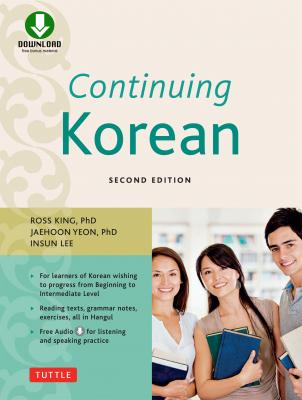Continuing Korean. Ross King
Читать онлайн.| Название | Continuing Korean |
|---|---|
| Автор произведения | Ross King |
| Жанр | Книги о Путешествиях |
| Серия | |
| Издательство | Книги о Путешествиях |
| Год выпуска | 0 |
| isbn | 9781462914920 |
| 44. | 이렇게 하기예요. (It is [a matter of ] doing it this way=) Let’s decide to do it this way. |
Nominalizer forms enable you to take an entire sentence; convert it into one big noun; and then use this noun as the subject, object, or some other part of a larger sentence.
-기-Conversion
| 45. | 여행을 해요. I travel. → 〔여행을 하-기〕NOUN |
| Incorporation of -기-Form into Larger Sentence | |
| 46. | 〔여행(을) 하기〕를 싫어해요. I hate to travel. |
| Sentence (42) neatly contains two direct objects: one within the -기 clause, and one that is the -기 clause itself. You can, of course, drop either particle 을 ~ 를 — or both of them. | |
| 47. | a.〔여행을 하기〕를 싫어해요. |
| b.〔여행을 하기〕 싫어해요. | |
| c.〔여행 하기〕 싫어해요. | |
| Another example: | |
| 48. | 가수가 나오기를 기다리고 있었어요. We were waiting for the pop star to appear. |
17.6. Other Nounlike Uses of -기 Forms
Observe the following examples.
| 49. | 모든 것을 다 잘하기(가) 어려워요. It’s hard to do everything well. |
| 50. | 공부만 하기가 재미없잖아요? It’s no fun to do nothing but study, don’t you think? |
| 51. | 수영하기를 좋아하세요? Do you like swimming? |
| 52. | 밖에서 놀기가 참 좋아요. It’s very nice to play outside, or I really like playing outside. |
| 53. | 혼자서 술 마시기를 싫어해요. He hates drinking alone. |
In each of these six sentences, a -기 form appears as subject or object, and in each case, the subject or object particle (as usual) is optional, so the -기 form without the particle is left in an absolute, or adverbial, construction.
Note that the class of verbs that can pattern with - 기 in this way is limited; one cannot, for example, say:
| 54. | *이 김치는 먹기가 너무 매워요. This kimchee is too hot to eat. |
Of the verbs learned so far in this course, the following are compatible with this pattern.
| 재미(가) 있-/없 | 귀찮- |
| 좋- | 싫- |
| 쉬w- | 어려w- |
| 힘(이)드-ᄅ- | 어때요? |
Thus, all are descriptive verbs, and (with the exception of 어때요) all are sensory verbs that participate in the -어해요 pattern for third persons. But it is not the case that all sensory verbs can be used this way, so be wary of trying out new verbs until you have heard them from a Korean yourself.
Here are some more examples of this kind of sentence.
| 55. | 한국말 배우기(가) 쉬워요? Is it easy to learn Korean? | |
| 56. | 한국말 배우기(가) 어렵지요? It’s difficult to learn Korean, isn’t it? | |
| 57. | 책을 읽기(가) 재미있어요. It’s fun to read books. | |
| 58. | A. | 서울에서 살기는 어때요? What’s it like to live in Seoul? [i.e., As far as living in Seoul (Topic)—what’s it like?] |
| B. | 살기는 좋지요. It’s good, of course! | |
| 59. | 이 집에는 방이 하나밖에 없어서 살기가 쉽지 않지요. It isn’t easy to live in this house, because it has only one room. | |
| 60. | 할머니는 너무 말씀을 많이 하셔서, 듣기가 싫어요. Grandmother talks so much I hate to listen. |
The expression 듣기 싫어요 I hate to listen is often used where we would say things like Ugh!, I don’t want to hear about it!; Must you say such things?!; What an awful thing (to hear)!; Stop talking! Likewise, the expression 보기 싫어요 means something like How disgusting (to see), or That (or he, she, etc.) makes me sick.
17.7. Plain Base + -기 시작하-: Begin to . . .
Another -기 pattern is the construction with 시작해요 begins, in which the -기 form is, optionally, the direct object of the phrase 시작해요. To say begins to do or begins doing you use a plain base + -기 form (with or without the direct object particle 를) and 시작해요 begins.
| 61. | 사람들이 버스에서 내리기(를) 시작했어요. The people started to get off the bus. |
| 62. | 비가 오기 시작해요. It’s beginning to rain. |
| 63. | 해가 나기 시작했어요. The sun has started to come out. |
| 64. | 한국말은 언제부터 배우기 시작하셨어요? [Since] When did you start learning Korean? |
| 65. | 무스를 바르기 시작했어요. I’ve started to use mousse. |
주의!
This construction is used with processive verbs only.
For adjectives—begins to be—you use an infinitive in -어 ~ -아 with the auxiliary verb 져요 begins [to be] (see section 18.6).
| 66. | 더워져요. It’s getting hot [= It’s beginning to be hot]. |
17.8. Any Base + -기 때문에:
